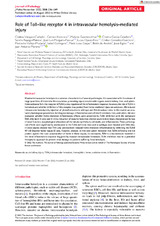Mostrar el registro sencillo del ítem
Role of Toll-like receptor 4 in intravascular hemolysis-mediated injury
| dc.contributor.author | Vázquez-Carballo, Cristina | |
| dc.contributor.author | Herencia, Carmen | |
| dc.contributor.author | Guerrero-Hue, Melania | |
| dc.contributor.author | García-Caballero, Cristina | |
| dc.contributor.author | Rayego-Mateos, Sandra | |
| dc.contributor.author | Morgado-Pascual, José Luis | |
| dc.contributor.author | Opazo-Ríos, Lucas | |
| dc.contributor.author | González-Guerrero, Cristian | |
| dc.contributor.author | Vallejo-Mudarra, Mercedes | |
| dc.contributor.author | Cortegano, Isabel | |
| dc.contributor.author | Gaspar, María Luisa | |
| dc.contributor.author | Andrés, Belén de | |
| dc.contributor.author | Egido, J. | |
| dc.contributor.author | Moreno, Juan Antonio | |
| dc.date.accessioned | 2023-11-27T11:01:42Z | |
| dc.date.available | 2023-11-27T11:01:42Z | |
| dc.date.issued | 2022 | |
| dc.identifier.isbn | 1096-9896 | |
| dc.identifier.uri | http://hdl.handle.net/10396/26257 | |
| dc.description.abstract | Massive intravascular hemolysis is a common characteristic of several pathologies. It is associated with the release of large quantities of heme into the circulation, promoting injury in vulnerable organs, mainly kidney, liver, and spleen. Heme activates Toll-like receptor 4 (TLR4), a key regulator of the inflammatory response; however, the role of TLR4 in hemolysis and whether inhibition of this receptor may protect from heme-mediated injury are unknown. We induced intravascular hemolysis by injection of phenylhydrazine in wildtype and Tlr4-knockout mice. In this model, we analyzed physiological parameters, histological damage, inflammation and cell death in kidney, liver, and spleen. We also evaluated whether heme-mediated-inflammatory effects were prevented by TLR4 inhibition with the compound TAK-242, both in vivo and in vitro. Induction of massive hemolysis elicited acute kidney injury characterized by loss of renal function, morphological alterations of the tubular epithelium, cell death, and inflammation. These pathological effects were significantly ameliorated in the TLR4-deficient mice and in wildtype mice treated with TAK-242. In vitro studies showed that TAK-242 pretreatment reduced heme-mediated inflammation by inhibiting the TLR4/NF-κB (nuclear factor kappa B) axis. However, analysis in liver and spleen indicated that TLR4 deficiency did not protect against the toxic accumulation of heme in these organs. In conclusion, TLR4 is a key molecule involved in the renal inflammatory response triggered by massive intravascular hemolysis. TLR4 inhibition may be a potential therapeutic approach to prevent renal damage in patients suffering from hemolysis. © 2022 The Authors. The Journal of Pathology published by John Wiley & Sons Ltd on behalf of The Pathological Society of Great Britain and Ireland. | es_ES |
| dc.format.mimetype | application/pdf | es_ES |
| dc.language.iso | eng | es_ES |
| dc.publisher | Wiley | es_ES |
| dc.rights | https://creativecommons.org/licenses/by/4.0/ | es_ES |
| dc.source | J. Pathol. November; 258: 236–249 (2022) | es_ES |
| dc.subject | Acute kidney injury | es_ES |
| dc.subject | TLR4 | es_ES |
| dc.subject | Intravascular hemolysis | es_ES |
| dc.subject | Hemoglobin | es_ES |
| dc.subject | Heme | es_ES |
| dc.subject | Oxidative stress | es_ES |
| dc.title | Role of Toll-like receptor 4 in intravascular hemolysis-mediated injury | es_ES |
| dc.type | info:eu-repo/semantics/article | es_ES |
| dc.relation.publisherversion | https://doi.org/10.1002/path.5995 | es_ES |
| dc.rights.accessRights | info:eu-repo/semantics/openAccess | es_ES |

